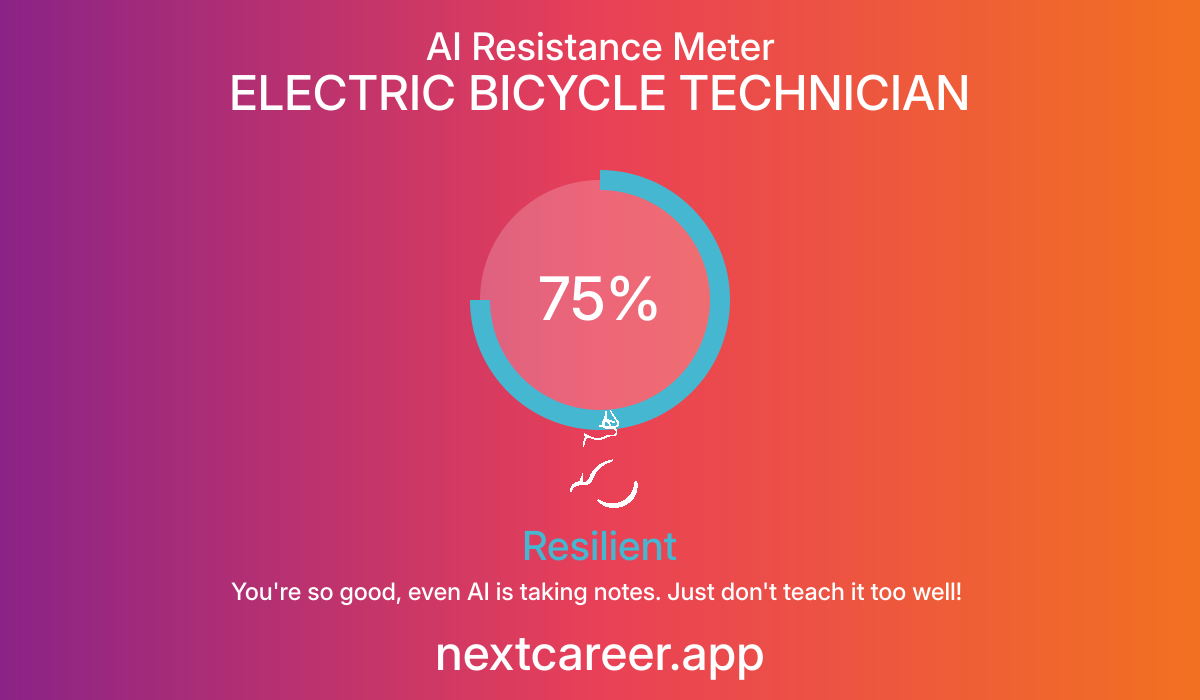AI Resistance Analysis
ELECTRIC BICYCLE TECHNICIAN
ELECTRIC BICYCLE TECHNICIAN
AI Resistance Score
AI Resistance Meter
Resilient
ELECTRIC BICYCLE TECHNICIAN
You're so good, even AI is taking notes. Just don't teach it too well!
Electric Bicycle Technicians require a blend of technical skills, hands-on physical abilities, and customer interaction capabilities. As AI advancements may support diagnostics and maintenance through advanced predictive analytics and IoT, the hands-on role remains heavily reliant on human dexterity and customer engagement, indicating a moderate to high AI resistance. Over time, while AI will aid in process efficiency and possibly routine labor tasks, the nuanced understanding and repair of bicycles—particularly in addressing unique customer requests and interactions—will still necessitate human expertise and intuition.
Electric Bicycle Technicians require a blend of technical skills, hands-on physical abilities, and customer interaction capabilities. As AI advancements may support diagnostics and maintenance through advanced predictive analytics and IoT, the hands-on role remains heavily reliant on human dexterity and customer engagement, indicating a moderate to high AI resistance. Over time, while AI will aid in process efficiency and possibly routine labor tasks, the nuanced understanding and repair of bicycles—particularly in addressing unique customer requests and interactions—will still necessitate human expertise and intuition.
Key Factors
- Cognitive Tasks: AI could potentially automate some routine diagnostic and repair tasks, reducing the cognitive workload of certain aspects of the job.
- Emotional Intelligence: Customer service aspects of the role where empathy, understanding, and communication are key remain largely resistant to AI.
- Physical Skills: The role requires hands-on mechanical skills that AI, as of now, cannot fully replicate, though robotics may assist in repetitive tasks.
- Creative Thinking: Problem-solving and customization of electric bicycles require creativity, which is a strength of human technicians.
Human Advantages
- Hands-on mechanical skills and troubleshooting that requires tactile feedback and nuanced understanding of bicycle systems.
- Emotional intelligence in customer interactions that build trust and loyalty, essential for service-oriented roles.
AI Vulnerabilities
- Routine maintenance tasks could be automated with advancements in diagnostics and repair technologies.
- If smart tools are developed that can execute repairs automatically, this could diminish the need for a technician.
Recommended Actions
- Invest in training programs focused on advanced electric bike technologies and customer service skills.
- Leverage AI tools as a support mechanism rather than seeing them as a threat—using diagnostics AI can enhance the technician's effectiveness.
- Stay updated on industry trends in e-bikes and potential changes in technology to adapt skills accordingly.
- Foster relationships with customers to build loyalty and trust, emphasizing the human aspect of repair services.
In the near term, advancements in AI-powered diagnostic tools will likely change how Electric Bicycle Technicians perform their roles, potentially automating simpler repairs and diagnostics. However, the demand for skilled technicians capable of handling complex repairs, who can also engage with customers meaningfully, will remain strong. In the long term, as bicycle technology evolves with AI integration, technicians might transition to roles that require higher-level integration of technology and enhanced customer service, rather than purely mechanical repairs. Continuous training and an emphasis on creative problem-solving will be crucial for technicians.

Why Calculate AI Resistance?
Understanding how AI-resistant your career is becoming increasingly important in today's rapidly evolving job market. Our analysis combines multiple factors including required human skills, technological adaptability, and future industry projections to give you a comprehensive view of your career's sustainability.